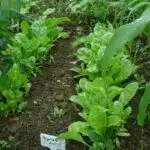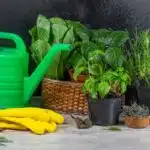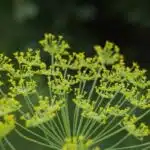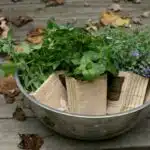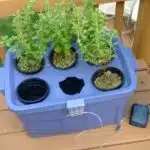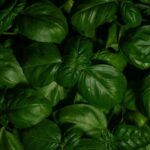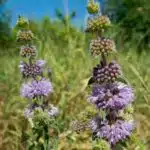Do you ever find yourself wishing for the ability to grow your own herbs, yet don’t have the space to do so? If so, then you are in luck! A recent survey has found that over 90% of people living in urban areas have access to a balcony or patio – making container gardening a popular and viable option for growing herbs.
Container gardening is an easy and economical way to bring fresh herbs into your kitchen. Growing your own herbs is not only convenient, but it also allows you to enjoy the freshest ingredients available. You can easily cultivate delicious culinary herbs such as thyme, rosemary, oregano and parsley without having to worry about maintaining an outdoor garden.
Harnessing the power of container gardening not only gives you access to fresh herbs year round, but it’s also a great way to add beauty and life to any outdoor space. With just a few simple tips and tricks, anyone can become an herb-growing master! Here are some easy tips on how to get started growing your own herbs in containers.
Selecting Herbs For Container Growing
When it comes to growing herbs in containers, the first step is selecting the right herb. It’s important to take into consideration a variety of factors, including the climate and soil type, when deciding which herbs to grow in pots. In most cases, it’s best to begin with an herb that is easy to plant and maintain. This could include some of the more common types such as rosemary, oregano, and thyme.
Next, it’s important to consider how much sunlight the herb will need in order to thrive. Most herbs require at least six hours of direct sunlight per day, so if you don’t have a bright spot available that meets those requirements then you may want to look for a different type of herb or another location in your garden where it can get enough sun.
Finally, make sure that you’re familiar with proper watering techniques so that your herbs get just enough water without becoming over-watered or under-watered. Depending on the type of herb you are growing and its specific needs, you may need to adjust your watering schedule accordingly. With these tips in mind and a bit of planning ahead of time, you’ll be ready to start growing healthy herbs in containers!
Choosing Containers For Growing Herbs
When it comes to selecting the perfect container for growing herbs, there are myriad choices. To put it simply, you can ‘grow high’ in tall planters, or opt for wider and shallower containers. This decision should be made with care – as a wise man once said, “the right tool makes all the difference”.
As a specialist in botany and gardening, I would recommend considering the size of your available space first. If you have limited space or need to move your pots around frequently, then smaller containers are likely best suited for your needs. On the other hand, if you have more room then larger containers can provide ample root space and ensure that your herbs get enough water and nutrients over time.
In addition to size, you should also choose a container material that suits your needs. Plastic containers are lightweight and inexpensive but may not be as durable as terracotta or ceramic pots which hold moisture better and last longer. Ultimately, regardless of the material chosen, make sure that it has adequate drainage holes to prevent root rot in your herbs!
Potting Soil For Growing Herbs
When it comes to growing herbs in containers, potting soil is just as important as the container itself. After all, the soil provides the support and nourishment for your plants to thrive. As a specialist in botany and gardening, I’d like to share some tips on choosing the right potting soil for your herb garden.
Your first decision should be whether you want to use a pre-mixed potting soil or mix one up yourself. Pre-mixed soils are readily available at most garden supply stores and come with different blends of ingredients already in them, ensuring that you get all of the necessary nutrients for your herbs. On the other hand, mixing your own soil can provide more control over the exact ingredients used and can save money in some cases.
No matter which option you choose, it’s important to make sure that your selection contains quality organic material such as peat moss, perlite, compost or vermiculite. All these materials help keep the soil loose enough so that air can reach the roots of your herbs while also providing much needed nutrients such as nitrogen and potassium. You also want to make sure that there is adequate drainage for excess water so that your herbs won’t become waterlogged and rot away.
With the right potting soil in place, you’re ready to position your containers for successful growth of your herb garden!
Positioning Containers For Growing Herbs
Planting pots of productive herbs can provide plenty of pleasure, especially when done properly. Positioning the pot correctly is paramount for producing a plentiful yield. As a specialist in botany and gardening, I’m here to help you understand how to position your containers for optimal herb growth.
First and foremost, it’s important to consider the type of herb you are growing. Different herbs require different levels of light and water. Knowing which category your herb falls in will help you determine the ideal placement for your container. Herbs that enjoy full sun need at least 6 hours of direct sunlight each day while others may prefer partial sun or shade. It’s also essential to take into account the temperature outside, as some plants may be more sensitive than others to extreme temperatures.
Second, make sure the pot has good drainage so that excess water can escape easily. If there isn’t enough drainage, this can cause root rot or other issues with your herbs. Additionally, it’s essential to keep an eye on how much moisture is retained in the soil since this could affect how well your herbs grow if they are oversaturated with water or not watered enough. Lastly, remember that if you plan on growing multiple types of herbs in one pot, select varieties that have similar requirements for light and water so they can all thrive together!
By taking these steps into account when positioning containers for growing herbs, you can ensure that your plants get everything they need to flourish—and reward you with a bounty of flavorful spices and delicious aromas!
Watering Herbs Grown In Pots
One would think that watering herbs grown in pots should be a simple, straightforward task—but ironically, it can be surprisingly tricky. For an experienced botanist or gardener, the challenge lies in finding the balance between keeping plants adequately hydrated and avoiding overwatering. Too little water can stunt growth and cause stress to the herbs. On the other hand, too much water can drown the roots and lead to root rot, so it’s important to ensure proper drainage for your containers.
The amount of water you give your herbs will depend on the type of herb and container size. Generally speaking, smaller pots dry out faster than larger ones, so they’ll need more frequent watering. Herbs like rosemary, oregano, sage and thyme prefer drier conditions, so allow the top 1-2 inches of soil to dry out before watering again, while more moisture loving herbs like mints and basil benefit from regular light watering.
Finally, it’s also important to use lukewarm water rather than cold – just as you would when making tea! Lukewarm water is better at penetrating soil quickly without shocking delicate roots with cold temperatures – which could easily occur with tap water straight from the fridge! With these tips in mind, you should have no trouble providing your potted herbs with adequate hydration – allowing them to thrive in their containers!
Fertilizing Herbs Grown In Containers
Gardening is a wonderful activity that can bring so much joy. It’s also extremely rewarding to be able to care for and watch your plants grow! When it comes to growing herbs in containers, fertilizing is an important step in ensuring healthy growth.
Fertilizing helps keep plants healthy by providing the necessary nutrients they need. Depending on the type of herbs you’re growing, you’ll want to choose a fertilizer that is suitable for their needs. Generally speaking, slow-release fertilizers are great for container gardening as they provide nutrients over time without having to be reapplied constantly. Additionally, organic fertilizers such as compost or manure are excellent choices as they help promote healthy soil and will benefit the overall health of your herbs.
When applying fertilizer to your herbs, be sure to follow the instructions on the packaging and make sure not to over-fertilize. Too much fertilizer can burn the plants and cause them harm, so it’s best not to use too much of it at once. Also be mindful of when you are applying fertilizer; typically it’s best done during spring or summer when your herbs are actively growing. With proper care and attention, you can have success with your potted herb garden!
Pruning Herbs Grown In Pots
Pruning herbs grown in pots is like taking a pair of scissors and giving your plants a well-deserved haircut. It’s an essential step to encouraging healthy growth and keeping the plant in check. When done correctly, pruning can be an incredibly satisfying process that encourages lush foliage and vibrant blooms.
As a specialist in botany and gardening, I know firsthand the importance of pruning your herbs in containers. Pruning helps maintain the overall shape and size of the plant, while also encouraging fuller growth. Additionally, it helps keep plants from becoming too woody or sprawling out beyond their container boundaries.
When pruning herbs grown in containers, always remember to use sharp scissors and keep cuts clean to avoid any damage to the plant. Also, try to trim off just enough material so as not to overstress the plant or encourage too much new growth at once. With these tips in mind, you will be on your way towards having healthy and beautiful herb gardens!
Overwintering Herbs In Containers
Many gardeners are surprised to learn that overwintering herbs in containers is possible. According to experts, up to 50% of herb varieties can be successfully overwintered in pots. With a little preparation and the right techniques, it’s possible to enjoy fresh herbs from your containers all year round.
To get started, here are three tips for successful overwintering:
- Use frost-resistant materials such as terracotta or plastic plant pots.
- Choose a sheltered position – away from strong winds and cold drafts.
- Ensure adequate drainage – use a potting mix with good drainage properties and add extra perlite if needed.
In addition to these steps, you may also need to provide additional insulation against the cold weather by wrapping the pot with bubble wrap or straw. You should also water your plants less frequently during winter months – this will help prevent root rot due to cold soil temperatures. Finally, it’s important to check regularly for pests and diseases, especially if your herbs have been growing in the same container for more than one season.
By following these simple steps, you can look forward to harvesting fresh herbs from your containers throughout the year.
Companion Planting For Herbs In Containers
Companion planting for herbs in containers is a fascinating and multifaceted science. It’s an art that requires both knowledge and creativity, as well as a bit of trial-and-error. By selecting the right plants to grow near each other, gardeners can create a thriving environment full of beneficial relationships between plants.
Through companion planting, one can utilize the benefits of certain herbs to promote healthy growth of other species nearby. Plants like basil are known to repel aphids, while dill attracts predatory insects like wasps that feed on destructive bugs. Certain types of mints have even been known to help prevent disease in nearby plants. Beyond pest management, companion planting can also be used for soil health and nutrient cycling, as well as increasing the production quality or quantity of herb crops.
To get started with companion planting for herbs in containers, it’s important to understand the basic principles behind it: what plants work best together (or not), how much space they need to grow properly, and when they should be planted. Knowing these basics will ensure optimal growth and productivity from your herb garden. With some research and planning ahead of time, you’ll soon be enjoying an abundance of fragrant herbs flourishing in harmony with each other!
Controlling Pests And Diseases Of Container-Grown Herbs
Just like any other plant, container-grown herbs can suffer from pests and diseases if left unchecked. As the old adage goes, an ounce of prevention is worth a pound of cure. That’s why controlling pests and diseases of container-grown herbs is an essential part of successful herb gardening.
First, it’s important to select containers that are pest-proof; plastic or glazed ceramic pots are good choices. Planting herbs in containers with holes in the bottom helps keep the soil well drained and less attractive to disease-causing organisms. Additionally, use potting mix specifically designed for container gardening instead of soil from outside. This will help reduce the number of potential pests that can be brought into your herb garden.
Finally, regular scouting for insects and checking for signs of disease should be done as part of your ongoing maintenance routine. If you notice any unsightly symptoms on your herbs, remove affected plants promptly and dispose of them away from other plants. Be sure to take proper safety precautions when dealing with sick plants or applying insecticides or fungicides as needed – never apply these products indiscriminately! With careful attention and vigilance, you’ll be able to keep your container-grown herbs healthy and pest-free so you can enjoy them all season long. Now let’s move on to harvesting these delicious herbs!
Harvesting Container-Grown Herbs
Harvesting container-grown herbs is an incredibly rewarding experience. With the right knowledge and care, you can expect yields of up to fifty percent more than other traditional growing methods! To ensure a successful harvest, it’s important to understand the proper techniques for harvesting your herbs.
First, identify when it’s time to start harvesting. Generally, this is when the herb is big enough that you can use it without damaging its growth cycle. Early morning is usually the best time to pick your herbs as this will give them the most flavor. When picking larger leaves, be sure to take only half of each plant at a time in order to encourage continued growth throughout the season.
Herbs should always be harvested with clean tools and handled gently after being picked. Make sure all of your tools are sharp and sterilized before using them on your plants in order to prevent any contamination or disease spread. Additionally, try not to bruise or damage the leaves during handling as this can reduce their quality and flavor.
Once you have harvested your herbs, you’ll need to properly store them in order to maximize their shelf-life. Herbs can be stored in a variety of ways such as freezing or drying depending on their intended use. It’s important that whatever storage method you choose is done so quickly and correctly to ensure optimal freshness. With these tips in mind, you’ll soon be enjoying flavorful herbs from your very own containers!
Using And Storing Container-Grown Herbs
Using and storing container-grown herbs is like a perfectly choreographed dance that requires specific steps. Knowing the correct timing of when to use or store your herbs will help ensure a successful harvest. Here are five tips for using and storing container-grown herbs:
- Harvest leaves just before they are used, as the flavor intensifies when the leaves are fresh.
- Herbs can be frozen in airtight containers or bags and stored for up to 6 months.
- If you plan to dry the leaves, spread them on a sheet of paper in an area with good air circulation, such as a porch or garage.
- For longer storage, hang bunches of herbs upside down in a warm, dry location out of direct sunlight until they feel brittle; then strip off the leaves and store them in an airtight container or bag for up to one year.
- To make herbal teas, steep 2 teaspoons of dried herb per cup of boiling water for 5 minutes; strain tea before drinking and discard spent herbs afterwards.
As a specialist in botany and gardening, I know that proper care is essential for maximum success with container-grown herbs. Poorly drained soil, too much sun exposure, inadequate watering and nutrient deficiencies can all cause problems with growth or development; however, by following these simple guidelines you can ensure that your plants will thrive in their containers! By providing the right environmental conditions and taking advantage of helpful tips like those outlined here, you can easily serve others with delicious fresh-picked herbs from your own garden!
Common Problems Growing Herbs In Containers
What a coincidence! Just when you thought you had mastered the basics of growing herbs in containers, common problems arise. This can be a terribly frustrating experience for any gardener – even the most seasoned ones. But don’t worry! Here are some key things to look out for: • Watering issues such as root rot or too much water • Pests like aphids or whiteflies • Disease caused by fungi and bacteria
When it comes to monitoring these issues, there is an important step that should not be overlooked: regular inspection of your herb plants. Look for signs of wilting, discoloration of leaves and stems, yellowing tips, and other abnormalities that could indicate a problem. If you spot anything unusual, take immediate action to prevent the issue from getting worse. For example, if you see signs of pests, use an organic insecticide or neem oil to get rid of them right away. If you suspect disease, apply a fungicide according to label instructions.
To ensure successful growth in containers, soil composition also needs to be taken into account. Check the pH level with a soil test kit and adjust accordingly by adding compost or other amendments as needed. Also consider whether your herbs are receiving enough light; if not, try repositioning them in an area with more sun exposure. With these considerations in mind and regular maintenance checks, you can prevent potential problems from developing and keep your herbs thriving in their containers!
Troubleshooting Tips For Growing Herbs In Pots
Growing herbs in pots may feel like a daunting task, but with the right troubleshooting tips and tricks, it’s easier than ever! From diagnosing common problems to finding solutions that work best for you, we’ll help you get started on your herb-growing journey. As a specialist in botany and gardening, I’m here to provide the best advice for growing herbs in containers.
First of all, it’s essential to know the signs of common problems such as yellowing leaves or brown spots. These could be caused by too much water or not enough light, so it’s important to properly diagnose what’s going wrong. It can also be helpful to observe your plants closely so you can catch any issues before they become too serious.
Once you know what’s causing the issue, it’s time to come up with some troubleshooting tips that will help fix the problem. This could mean adjusting how often you water your plants, moving them to a better location with more sunlight, or adding fertilizer if needed. Additionally, if pests are present then it might be necessary to take additional steps like using natural pesticides or manually removing them from your plants. There are many ways to keep your herbs healthy and happy in their containers.
No matter what issues arise while growing herbs in containers, there are always solutions available that will get them back on track towards thriving! With these troubleshooting tips at hand, you’ll have no problem getting the most out of your herb-growing experience and providing fresh and flavorful ingredients for your kitchen creations!
Benefits Of Growing Herbs In Containers
Gardening gurus and green thumbs alike can reap the rewards of growing herbs in containers. From fragrant foliage to flavorful fruits, herbs are an easy, accessible way to bring life and flavor to any garden. With a few simple steps, anyone can enjoy the bountiful benefits of cultivating herbs in containers.
First is fragrant foliage. Herbs are renowned for their scent, and when grown in a container, they can be moved around easily to bring those scents closer to where you want them most. Container-grown herbs also make it easier to keep track of which plants are ready for harvesting when; simply pluck the desired herb from its pot and savor its freshness!
Second is flavor. Herbs grown in a container are much easier to control than those planted directly into the ground—this makes it easier for gardeners to adjust the amount of water and nutrients each plant receives, ensuring that their herbs get just what they need for maximum flavor potential. Plus, with a container herb garden, you don’t have to worry about soil quality or pesky pests getting in the way of your culinary creations.
Finally is convenience. Growing herbs in pots makes it easy to move them around as needed; whether you’re looking for more natural light or just want something brighter on your balcony, your herb garden will always be mobile and manageable. With such effortless accessibility comes plenty of opportunity for experimentation; try different combinations of plants together and mix up your watering schedule until you find what works best!
Frequently Asked Questions
How Often Should I Rotate My Herbs In Containers?
It is estimated that over one-third of the world’s population grow herbs in their gardens or containers. Growing herbs in containers can be a rewarding and sustainable activity, but it requires frequent rotation of your plants to ensure they get enough sunlight, moisture and nutrients. So, how often should you rotate your herbs in containers?
In order to ensure optimal growth and yield of your herbs, consider rotating them every two weeks. This will allow you to maintain an even distribution of sunlight across all your plants, as well as give them access to additional sources of water and nutrients which may not have been available in their original positions. Additionally, rotating the plants will also help reduce any risk of over-watering or nutrient absorption from becoming too concentrated in one spot.
It is important to note that some herbs such as mint, thyme, oregano and chives may require more frequent rotation than others due to their higher demands for sunlight and other resources. If you are unsure about how often you should rotate your particular herb varieties, consult with a specialist in botany and gardening who can provide tailored advice based on your specific needs. With the proper guidance, any gardener can successfully cultivate healthy herbs in containers for years to come!
What Is The Best Way To Start Herbs From Seed In Containers?
Starting herbs from seed in containers can be likened to planting a garden in a tiny patch of land. It takes a bit of finesse, but with the right kind of attention and care, it’s a rewarding experience for both the gardener and the plants! To get started on this journey, there are certain steps that must be taken.
First and foremost, it’s important to make sure you have the right container for your herbs. Look for something deep enough so that each plant can grow without being crowded out by its neighbors. Make sure it has adequate drainage holes as well. After you’ve selected an appropriate container, fill it with well-draining soil and prepare it for planting your seeds.
Once your container is ready, sow your herb seeds according to their instructions on the seed packet. Then cover them lightly with soil and lightly water them until they germinate. Once they start growing, keep them in a place where they will get plenty of sunlight but not too much heat or cold. Also, keep an eye on the moisture levels in their soil – too dry or too wet can both cause problems for your plants.
Finally, when tending to your herb garden over time remember not to let it become overgrown; trim away any dead foliage or flowers regularly to promote healthy growth and give each plant enough room to flourish. With these tips in mind you’ll be on your way to cultivating lush herbs in no time!
Are There Any Herbs That Are Better Suited To Growing In Containers?
As the old adage goes, a little knowledge goes a long way when it comes to gardening. When growing herbs in containers, there are some plants that are better suited for this type of environment. Here is what any botanist or gardener needs to know:
- Herbs like basil, oregano, parsley, thyme and chives all thrive in pots and containers.
- Rosemary is well known for its ability to tolerate both dry and wet conditions, making it an ideal choice for container gardening.
- Mints such as peppermint and spearmint can spread quickly in the garden but they do well when planted in containers as they are easily controlled.
- Lavender can be grown in containers due to its need for full sun and well-drained soil conditions.
- Sage is another herb which can be kept under control with container gardening as it prefers low maintenance soil conditions and makes a great addition to any patio or balcony garden!
Container gardens offer many benefits over traditional gardens including ease of care and portability – perfect for small spaces such as balconies or patios! For those looking to start an herb garden, growing herbs in containers is the way to go! With careful planning and consideration of your space limitations, you can create a vibrant herb garden that will bring years of joy with very little effort!
How Much Direct Sunlight Should My Containers Receive?
When it comes to growing herbs in containers, the amount of sunlight is a key factor that needs to be considered. As with most plants, herbs thrive with plenty of sunlight and will require at least 6 hours of direct sunlight per day. It’s important to ensure your containers receive enough sun not just for the health of your herbs but also for their growth, as it helps them produce more leaves and flowers.
Placing your containers in an area that gets adequate sunshine means you’ll get the most out of your herbs. A south-facing window or balcony is ideal, but if this isn’t possible then look for somewhere else where they can get enough light throughout the day. You may need to move the containers around during different times of year as the sun changes its position in the sky.
It’s therefore essential to assess how much direct sunlight your herb containers will be receiving before planting them, so you can make sure they get all the light they need for growing and benefiting from all their flavourful properties. Doing this will help you create a flourishing herb garden and enjoy delicious meals using freshly picked herbs from your very own container garden!
Are There Any Special Considerations For Growing Herbs In Containers During The Winter Months?
When it comes to growing herbs in containers, it’s important to consider the winter months. Not all herbs are hardy enough to survive frost, and some may require special care during cold weather.
If you’re looking to continue growing your herbs through the winter, the first thing you should be aware of is which herbs can withstand temperatures below freezing. Herbs like rosemary, chives and thyme can handle a light frost, while oregano and sage may need protection from colder temperatures. Some other herbs such as basil, tarragon and mint will not survive any frosts at all.
When caring for your herbs in containers during the winter months, make sure they are getting enough sunlight each day – six hours per day is generally recommended. If possible, try to place your containers in sheltered areas that protect them from wind or rain. Keep in mind that the soil in containers will dry out more quickly than if they were planted directly into the ground; so make sure you keep an eye on moisture levels and water regularly if necessary. Additionally, you should add a layer of mulch around your plants to help protect them from extreme temperatures.
As with any type of gardening, taking extra precautions when growing herbs in containers during colder weather will give them their best chance for survival – ensuring that you can continue to enjoy fresh herbs year-round!
Conclusion
Growing herbs in containers can be a fantastic way to add flavor and color to your meals, but it takes some effort. With just a few simple tips, you’ll be able to have success with these plants in no time. Rotating your potted herbs regularly is important for even sunlight exposure, and starting them from seed is the best way to get them off on the right foot. Herbs that are better suited for growing in containers include parsley, chives, thyme, oregano, and mint. Make sure that your containers receive at least six hours of direct sunlight each day and take special precautions during colder months to keep your plants healthy.
It may come as a surprise, but there’s no need to fear the gardening challenges associated with growing herbs in containers. With some patience and care, you can enjoy a steady supply of delicious herbs all year round. Whether you’re an experienced gardener or just getting started with container gardening, these easy tips will help guide you in creating your own miniature herb garden. So don’t be intimidated by the thought of tending to potted plants; with the right knowledge and preparation you can easily become an expert herb gardener!




